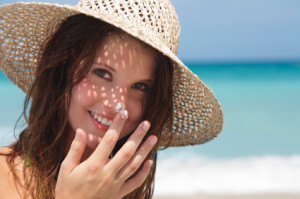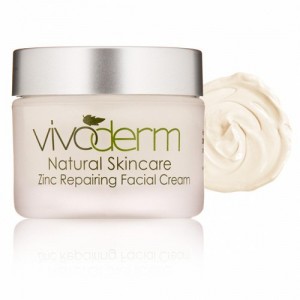NATURAL SKIN PRODUCTS FOR SUN PROTECTION
Sun Protection and Photo Aging
“Photo-aging” is the term used to describe the damage that is done to the skin from prolonged exposure to the sun’s UV radiation The amount of photo aging that develops depends on different factors such as a person’s skin color and their history of long-term or intense sun exposure. Studies have shown that repeated ultraviolet (UV) exposure breaks down collagen and impairs the synthesis of new collagen. The sun also attacks our elastin causing the skin to become loose, wrinkled, and leathery.

young lady applying sunscreen at the beach
Ultraviolet radiation penetrates the layers of the skin. Both UVA and UVB rays cause damage leading to wrinkles, lower immunity against infection, aging skin disorders, and cancer. However, they appear to damage cells in different ways.
UVB rays are the main cause of sunburns, and primarily affects the outer skin layers. UVB is most intense at midday when sunlight is brightest. Slightly over 70% of the yearly UVB dose is received during the summer. Only 28% is received during the remainder of the year.
UVA rays penetrate more deeply and efficiently. The intensity of UVA rays is less dependent on the time of day and season of the year than UVB rays. For example, you receive only about half of your yearly UVA dose during the summer months, with the balance spread over the rest of the year.
Almost all dermatologists and doctors agree, sun protection products should be worn year round. It is important to apply sunscreen diligently during the summer months as it is most intense at this time. But just because you’re a mountain dweller, don’t think you can avoid the sun’s rays there either. UV rays are almost twice as harsh at higher altitudes. Combined with the reflective snow surface, high altitude sun can damage skin at a surprisingly fast rate and cause just as much damage as sun burns on the beach.
Sunscreen Product Facts
- Broad spectrum only should be used.
- SPF is only related to UVB protection and does not provide a reference to the UVA protection in the product.
- All sunscreens will have UVB protection, which is reflected in the SPF.
- If skin sunburns in 10 minutes, a properly applied sunscreen SPF 15 means they will burn in 150 minutes
- Physical screens reflect light whereas chemical screens absorb UV converting the energy into heat
- SPF15 blocks 87.5% of UVB and SPF 50 blocks 98% of UVB.
If you are looking for the best all around protection against UV rays, Zinc Oxide is your best choice. Zinc has a superior ability to protect your skin from UVA radiation. So, it is the natural, organic star of the skin care products available today. Zinc may leave a slight ‘white-cast’ on your skin, but considering the alternative chemical-laden, inflammatory or allergy-inducing options for sun protection today, zinc is an excellent choice for sensitive skin. Scientists are currently working on a “micro-fine” version of zinc to eliminate this effect without changing the power of the sunscreen itself.

Anti-Acne, Sun protection SPF 15
Always look for a sunscreen product that is dual-spectrum, meaning it blocks both UVA and UVB rays. UVA rays are the rays that cause wrinkles and skin aging, while UVB rays produce tans and burns. Applying sunscreen to not only the face but body is important. Sunscreen should be applied daily and even multiple times during the day depending on your outdoor activities. Sun protections no lower than SPF 30 should be applied to the face and body.
Many may also be unaware they can EAT for sun protection! Natural anti-oxidants from fresh berries, green tea, spirulina and many other foods act as natural barriers to the harmful effects of the sun.
The Sunscreen Product Debate – Potentially Harmful Ingredients of Sunscreens
You may be wondering, “How effective are sunscreens in protecting the skin against UVA and UVB rays from the sun? How harmful are their ingredients? Do sunscreens damage more than they protect?” Many have reported the very ingredients in sunscreens that offer sun protection, have also been found to have adverse side effects
While the debate between whether sunscreens are safe or not continues, chemical watchdog, the Environmental Working Group reported 84% of sunscreen products are harmful to consumers.
The bottom line is this. It is up to you as the informed consumer to research all skin care and sunscreen products you use, not only for efficacy but for safety as well. You only have one body, do your best to protect it and treat it well. Avoid prolonged exposure to the sun and take necessary precautions and measures to increase your natural sun protection factor and avoid future skin damage.




